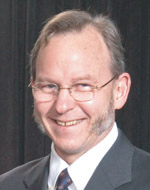Stress Corrosion Cracking and Environmental Effects on Fracture of Structural Materials in Nuclear Power Systems
Peter L. Andresen
1GE Global Research Center, One Research Circle CE 2513
Schenectady, NY 12309 andresen@ge.com
ABSTRACT
As fatigue and fracture has become better quantified and managed, environmental effects on cracking have become more prominent. The effects of environment on mechanical properties are complex, and not easily anticipated theoretically or fundamentally. Even after many decades of studies in high temperature water, important new issues are often discovered.
The world of environmental cracking has been artificially divided into initiation and growth, although there is no agreement on the crack development regime uniquely associated with initiation. Most parameters that accelerate crack growth also accelerated crack initiation, suggesting that common mechanistic features exist. However, all kinds of phenomena can be responsible for crack initiation, e.g., inclusions and other metallurgical defects, fatigue, oxidation (pitting, grain boundary corrosion, etc.), mechanical cracking of hardened surface layers, weld defects, etc. Further, most data on crack initiation is burdened by poor experimental design: too few replicates, lack of on-line detection of incipient cracking, stress relaxation, unrealistic stress and chemistry conditions, etc.
Crack growth studies have proven to be much more quantitative, and inherent resistant to crack advance is key to any design. Stress corrosion crack growth rate data reveal that all grades of stainless steels and nickel alloys are susceptible in high temperature water, whether the dissolved O2 or H2 is high or low, the water is theoretical purity or buffered or contaminated, the temperature lower or higher, etc. Sufficiently high resolution measurements can track SCC response into regimes that were previously hidden “below ground level”, and show that all variables follow a well-behaved continuum and have similar effects in stainless steels and nickel alloys. This suggests that the underlying processes and mechanisms of crack advance are similar in these various alloys and environments. This lecture summarizes the common and the distinctive elements in stainless steel and nickel alloys in boiling and pressurized water reactor environments, including the effects of corrosion potential, water chemistry, cold work, stress intensity factor, temperature, sensitization, Si and grain boundary particles.
Also highlighted is a review of SCC problems in light water reactors and why they occurred, an introduction into some of the underlying science, an emphasis on the need for the highest quality experiments, comments on the general absence of thresholds and immunity in SCC, and an introduction to modeling and life prediction.




 DR. PETER L. ANDRESEN
DR. PETER L. ANDRESEN
Principal Scientist Phone Numbers:
Corrosion & Electrochemistry Lab Work: 518-387-5929
Ceramics & Metallurgy Technology Fax: 518-387-7007
GE Global Research Center
One Research Circle Room CE 2513
Schenectady, New York 12309 andresen@ge.com
EDUCATION
B.S. in Materials Engineering (Cum Laude), 1972, Rensselaer Polytechnic Institute.
Ph.D. and M.S. in Materials Science, 1978 and 1974, Rensselaer Polytechnic Institute.
EXPERIENCE
Dr. Andresen’s expertise is in the area of corrosion and environmental effects on mechanical properties and integrity of materials. His research has focused on corrosion and environmental fracture of iron- and nickel-base alloys under conditions of interest to the energy and plastics industries. He also studied corrosion fatigue of Cu-Al alloys and has published and consulted widely on pitting, general corrosion, erosion and polarization behavior in aqueous and organic media. In addition to numerous presentations of his research, Dr. Andresen has given many invited lectures at technical and educational symposia.
Prior to GE, Dr. Andresen worked as an independent consultant specializing in corrosion and metallurgical failure analysis. Dr. Andresen is the author of over 400 publications, holds twenty eight patents, has given dozens of invited talks and written numerous chapters for books. He is a Fellow of the American Society for Metals and the National Association of Corrosion Engineers, and is a member of the International Cooperative Groups on Irradiation Assisted Stress Corrosion Cracking and on Environmentally Assisted Cracking. He has served in many capacities in professional societies, including currently on the Board of Directors of NACE; Board of Editors for Corrosion Journal; Chairman of the NACE Research Committee; NACE Awards Committee, Advisory Panel / Quick Response Team for Halden, Norway and MIT test reactor programs; and various as head of various committees and symposia for NACE, the Environmental Degradation meetings, the International Cooperative Group on Irradiation Assisted SCC; and ASM. He has served on several DOE Expert Review Panels for Fusion Energy and Radioactive Waste Disposal, on the RPI Trustees Committees for Faculty and Staff Compensation and Presidential Search, and on several thesis committees. He has received two Whitney Gallery of Achievers Awards and the Dushman Award from GE, the Speller Award from NACE, and was selected as one of “50 Stars to Watch” by Industry Week in 1996.



